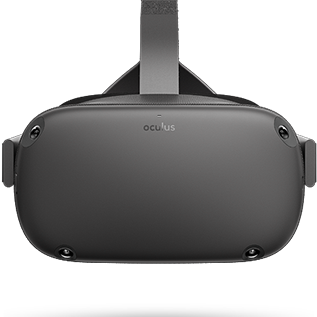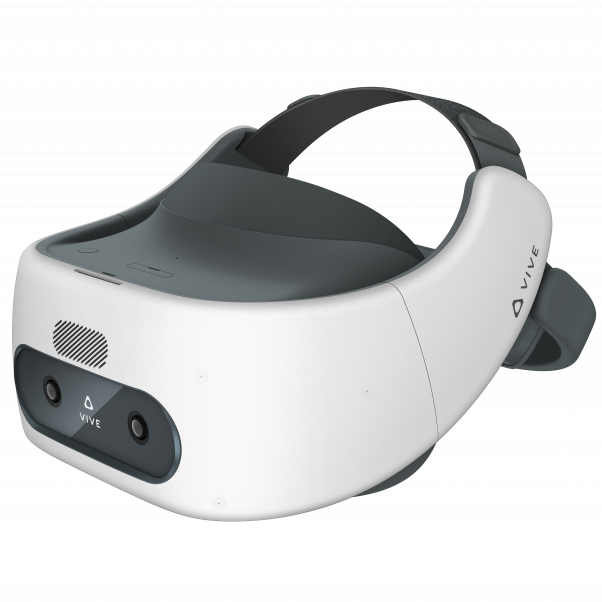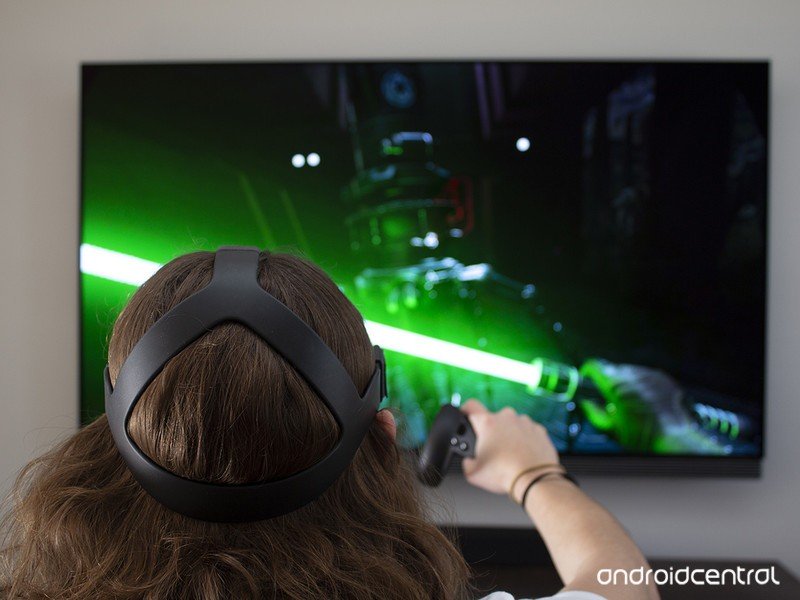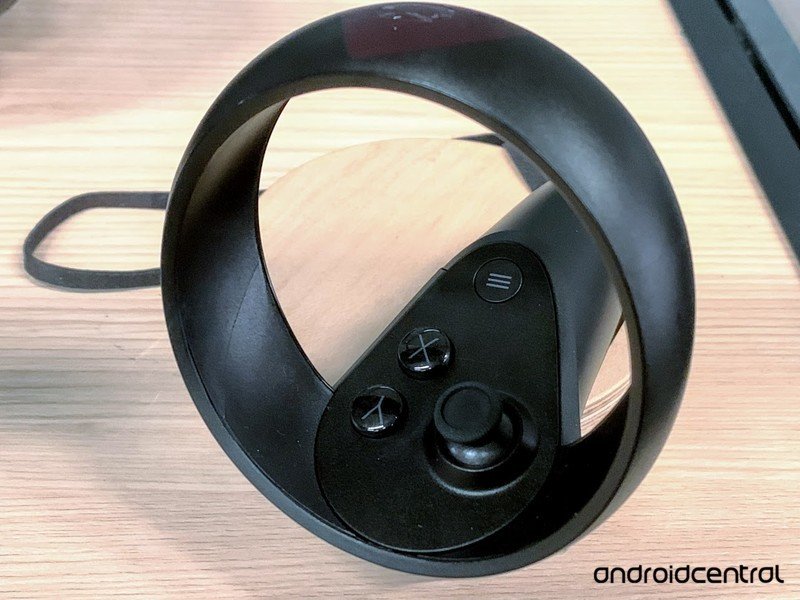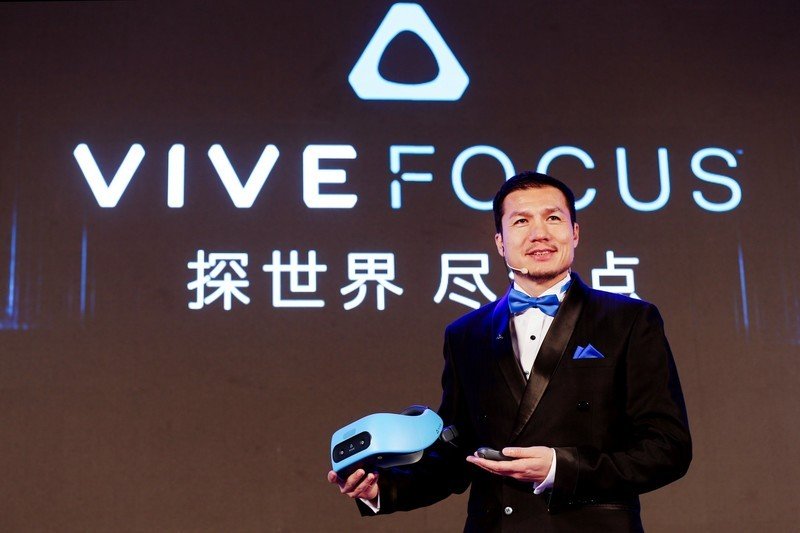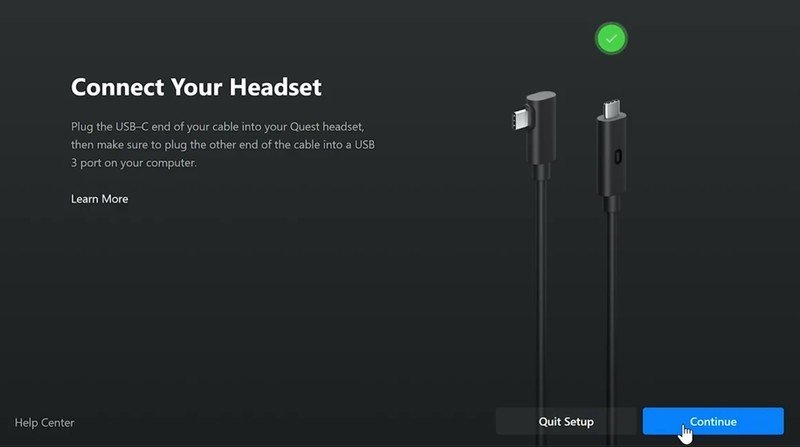Best all-in-one VR
Oculus Quest
Pros
- Affordable price
- Better exclusive games
- Lighter, more stylish design
- More tracking cameras
Cons
- More expensive / fewer games
- No expandable storage
- PC connection requires a wire
The Oculus Quest makes a strong case for the best all-in-one VR headset on the market. Its superior inside-out tracking and Guardian room tracking help you move fast without desyncing or smashing into a wall, and its visuals without PC power will impress all but the most hardcore VR fans. It also offers a curated library of excellent VR games optimized for the Quest.
Not just for business
HTC Vive Focus Plus
Pros
- Designed for business use
- Wider FOV
- Larger subscription-based library
- Wireless PC VR
Cons
- Twice the price
- Lower-quality game library
- Heavier
For a much higher price point, the Vive Focus Plus ekes past the higher-selling Quest in its FOV, refresh rate, and other important specs. It offers impressive features for specialized users: a kiosk mode for showcases, a wireless connection to PC VR games, and a subscription option for a larger library of games.
HTC markets the Vive Focus Plus as being “for enterprise” in North American and European markets, but as a consumer product in Asia. While the all-in-one wireless Oculus Quest has received rave reviews and has sold very well in the west, the Vive Focus Plus has been overlooked by most casual buyers. Whether you want a VR headset for business or pleasure, the Vive Focus Plus shouldn’t be ignored; but this guide should help you decide which device better fits your needs.
Checking out the specs
Comparing the Quest and Vive Focus Plus is as much about their similarities as their differences. You might expect the Vive to vastly overpower the Quest considering its higher price point, when in fact, its internal specs only surpass the Quest in a few key areas.
| Quest | Vive | |
|---|---|---|
| Wireless / All-in-one? | Yes | Yes |
| Processor | Snapdragon 835 | Snapdragon 835 |
| Graphics Card | Qualcomm® Adreno™ 540 GPU | Qualcomm® Adreno™ 540 GPU |
| Memory | 4GB | 4GB |
| Storage | 64 or 128 GB | 32 GB |
| SD card slot | None | Up to 2 TB |
| Controller type | 2 Oculus Touch controllers | 2 VIVE Focus Plus controllers |
| Display panel | Dual AMOLED | Dual AMOLED |
| Resolution | 1440 x 1600 per eye | 1440 x 1600 per eye |
| Refresh rate | 72 Hz | 75 Hz |
| IPD adjustable range | 58mm to 72mm | 60.5-74mm |
| FOV | ~100º | ~110º |
| Battery life | Up to 3 hours | Up to 3 hours |
| Battery recharge | ~2 hours | ~2 hours |
| Weight | 571g | 695g |
| Type of tracking | Inside out (no external sensors) | Inside out (no external sensors) |
| Degrees of Freedom (DoF) | 6DoF | 6DoF |
| Number of tracking cameras | four | two |
| Controller tracking | Tracked via camera | Tracked via ultrasonic sensors |
| Audio integration | In-strap audio | In-strap audio |
| Number of 3.5mm audio jacks | Two | One |
| Available games, apps, and experiences | ~150 via Oculus Store | ~2000 via Viveport / ~600 with Infinity |
| Link to PC VR games? | Yes, via Oculus Link | Yes, via Viveport Infinity |
With the same mobile Snapdragon CPU and 4GB of memory in both headsets, you’ll see the same level of performance in both. The Vive Focus Plus has a slightly improved refresh rate, but the difference of just 3 Hz won’t be noticeable to most gamers. Even the lens resolution is the same, meaning whichever VR games you buy, they’ll appear just about the same no matter which headset you buy.
Despite the hardware similarities, these VR headsets aren’t interchangeable. We’ve found significant positives and negatives for both devices where one clearly outshines the other.
Visual quality
Both headsets have dual AMOLED lenses with 1440 x 1600 resolution in each eye. Each one lets you manually adjust the interpupillary distance (IPD) to match your face. While they differ slightly in minimum and maximum IPD, both have a range of about 14mm that encompasses the majority of face sizes. So only a minority of users with uncommonly wide or narrow faces may need to avoid one headset or the other.
When it comes to field of view (FOV), HTC has traditionally beaten Oculus in both height and width of field, and nothing has changed for this generation. Disappointingly, the Oculus Quest only matches the original Rift CV1 in FOV according to Road to VR, losing to the Go and Rift S. And while the HTC Vive Focus Plus wins with its 110º view, that number hasn’t changed since the original HTC Vive.
When it comes to field of view (FOV), HTC has traditionally beaten Oculus in both height and width of field.
Arguably, FOV matters less for an all-in-one headset, since it’s much easier to spin to see your periphery without wires trailing behind. Generally speaking, some users dislike the unnatural feeling of something restricting your vision, while others acclimate to it quickly. If you haven’t tried VR before and don’t know your tolerance for narrow vision, consider erring on the side of clear vision and choosing the Focus Plus. Yet we believe that visual quality matters more than a slightly wider FOV.
In that regard, the Quest has some quality-of-life perks but also a significant downside. On the plus side, Oculus found a way to fix chromatic aberrations—a loss of image quality due to the need to separate RGB colors into individual layers at the edge of VR lenses—without significant power drain. This gives you a crisp, consistent visual field that doesn’t become distractingly fake-looking in your periphery. Also, thanks to Oculus’ exclusive Dynamic Fixed Foveated Rendering, games will prioritize crisp graphics in the center of your vision, while keeping the lower-resolution graphics in the periphery as high as the Quest can currently handle.
On the other hand, the Quest does have a notoriously large nose gap, which causes a frustrating glare across the screen. We found simple ways to close the nose gap, but keep in mind that the Quest has this proven issue out of the box, while the Focus Plus has fewer reported issues with this.
Tracking
Both devices track your movement throughout a room using 6DoF inside-out tracking. Your headset and controllers can be followed in six directions: forward, backward, up, down, left and right, all without any external sensors.
Both devices also have a method of monitoring your external environment, enabling a mixed-reality mode in which you can see your surroundings in black-and-white. In either case, you will set up a play area for room-scale tracking; if you leave this area during an experience, it will automatically switch to “Room View” on the Focus Plus or “Passthrough+” on the Quest. While somewhat jarring in the moment, this helps you avoid injury and gives you the confidence to run around your customized play space without fear.
Oculus has recently improved this mode—hence the “plus” added to Passthrough—to improve the stereo-correct tracking and reduce eye strain while in this mode. HTC used to rely on Steam VR functionality to program boundaries for them but finally began to add its own custom program to newer headsets last year.
Headset tracking may be relatively similar in style and performance for both devices, but controller tracking works very differently between the two devices.
Headset tracking may be relatively similar in style and performance for both devices, but controller tracking works very differently between the two devices. To enable 6DOF tracking in its Oculus Touch controllers, Oculus added two extra cameras to the headset itself. The Touch controllers emit 15 infrared LEDs each, allowing the cameras to pick up the exact position of your hands via visual data. Whereas for the Vive Focus Plus controllers emit ultrasonic sounds at a specific frequency, allowing the headset to pinpoint their locations without any visual data.
Determining which system works better is a complicated debate. Vive claims that its ultrasound solution uses very little power, freeing up computational space for other programs. Plus, it’s known that infrared tracking suffers in any space with natural light or not enough light.
On the other hand, most VR systems use infrared because it’s proven to work simply and effectively in the right conditions. At the same time, ultrasonic tracking is more experimental and unproven at this point. And our Oculus Quest review noted how impressive the Quest tracking system is for fast-paced games.
Gaming Content
As with any video game console war, consumers care just as much about exclusives as they do about the console’s hardware. In the case of the battle between these two devices, the more consumer-focused Oculus Quest has invested more into AAA exclusives than the enterprise-focused Vive Focus Pro.
You’re more likely to be happy with an Oculus Store purchase in terms of quality but less happy in terms of price.
Some of the most famous VR titles—Beat Saber, Vader Immortal, Moss, Job Simulator, Star Trek: Bridge Crew, Keep Talking and Nobody Explodes—all feature on the Oculus Store but not on Viveport. Viveport does have a few exclusives of its own, such as Game of Thrones experience Beyond the Wall and impressive mixed-reality exercise app HitMotion: Reloaded. Generally, though, Viveport is known for more indie games and shovelware, while Oculus has more rigorous rules that each game must pass inspection and be optimized for their devices before appearing in their store.
In practice, this means that you’re more likely to be happy with an Oculus Store purchase in terms of quality, but less happy in terms of price. Oculus games tend to have high sticker prices, especially considering most VR games have short runtimes.
If you’re someone who prefers Netflix-style subscriptions for content rather than buying individual expensive games, the Focus Plus offers an excellent deal with Viveport Infinity. For $13 a month (or $108 if you pay upfront), you get access to a library of (currently) over 600 wireless experiences. Oculus users looking for a similar model can subscribe to Viveport Infinity themselves, but they can only access the games on their Quest through a wired Oculus Link connection to a VR-ready PC.
Business content
If gaming is a secondary concern, however, and you need a headset primarily for business or development. It’s fair to say that the HTC Vive Focus Plus offers a clear advantage in this category (if you’re willing to pay for that advantage).
HTC offers an Enterprise Advantage program for the Vive Focus Plus that lets you activate features like Kiosk mode, in which you can restrict all but certain apps to users. This is the perfect way to simplify the VR experience when trying to show off a demo on the show floor.
Beyond all of the Vive business features, the option for upgradeable storage in the Vive Focus Pro also offers an advantage.
The EA program also offers Batch Configuration and Content Deployment. In essence, if you need to buy and use multiple headsets for your business, you can program all of the settings or deploy your content to them simultaneously, avoiding tedious, repeated set-up time. Also, they offer encryption services to protect your proprietary data.
Beyond all of the Vive business features, the option for upgradeable storage in the Vive Focus Pro also offers an advantage. With the microSD card slot, you’re able to upload up to 2 TB of data to the headset if you’re willing to buy the appropriate card. This would allow a real estate agent, for example, to upload more visual walkthroughs of different houses on the same device, where a 64 or 128GB maximum might limit you on the Oculus Quest.
With the Quest, you can certainly convert it into a business-oriented device. With its Android-based OS, the Quest can sideload any apps you need via developer mode, provided you’re comfortable diving more into the back end of the device. It’s just not specifically designed for it, and many users will be more comfortable with a business device that doesn’t feel like it needs to be “hacked.”
Streaming
For Vive Focus Plus users, another excellent perk of Viveport Infinity is that you can stream any PC VR games to your headset with a 5GHz Wi-Fi connection. The Oculus Quest, as mentioned above, only has the wired Link option available. Of course, wired data transfer generally has better speed and reduced latency compared to a wireless transfer, potentially making Oculus Link a more reliable option.
Ultimately this comes down to comfort and convenience versus performance. The whole point of all-in-one headsets is to not deal with wires, but playing a stuttering, low-performance version of a high-graphics PC game over Wi-Fi isn’t fun either. We recommend sticking with the wired option until it’s proven that Wi-Fi can handle the most graphically intensive titles.
Price and preferences
The impressive specs on the Oculus Quest make it very difficult for HTC to justify doubling the sticker price for the Vive Focus Plus. However, because of Quest production shortages due to the coronavirus, retailers that still have stock are jacking up the Quest sticker price closer to the Vive Focus Plus, making your decision of which to buy more complicated.
If price isn’t an object, you can certainly consider the Vive Focus Plus pro as a viable option. It has a massive native library of content, a wider field of view, and wireless PC-to-headset streaming that shows enormous promise. However, the Quest has a strong library of content, backed by Facebook’s willingness to pay for exclusives, and recent additions to the Quest UX like hand tracking, Passthrough+, and Oculus Link proves the company is fully invested in improving the headset beyond an already solid level of performance.
Unless you’re buying specifically for business VR solutions, we maintain that the Quest is the default choice for all but a certain niche of VR fans.
Best all-in-one VR
Oculus Quest
$565 on Amazon $537 at Walmart
Excellent tracking for room-based VR
Oculus Quest wildly surpasses what a mobile, wireless VR headset should be able to achieve. Its inside-out tracking does an excellent job without external sensors, and the combination of excellent Quest games and the Oculus Link option for PC-level experiences gives buyers more than enough high-quality content to enjoy.
Not just for business
HTC Vive Focus Plus
A potential game-changer with wireless PC VR
Its high price tag and marketing towards business owners will scare off many buyers, but there is plenty to be excited about for casual VR fans if you can afford it. Owners of VR-ready PCs will love the option to play more powerful VR experiences without being tethered, and Viveport Infinity’s extensive library offers endless, affordable entertainment.

